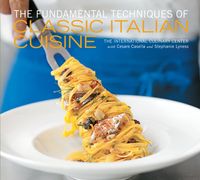Advertisement
Pasta secca is a factory-made product fashioned from semolina flour, which is milled from the berry of a golden-colored variety of wheat called grano duro (durum wheat), a hard-wheat variety that originated in the Mediterranean. The dough is shaped by being pressed through perforated dies, then dried. The availability of the wheat, and a climate that was perfect for drying the dough, made southern Italy the natural home of pasta secca.
The quality of pasta secca is determined by the quality of the grain and the drying process. Artisanal pasta secca is made by essentially the same method as commercial dried pasta, with some important differences: The dies used to extrude modern, industrial dried pasta are made from Teflon, which produces a very slick, smooth surface on the pasta. Artisanal producers have returned to the use of traditional bronze dies that are more difficult to clean and maintain, but produce a pasta with a coarse and porous texture. The rougher surface of artisanal pasta captures sauce, giving it something to adhere to, while sauce tends to slide off the slick surface of standard-quality pasta. Additionally, artisanal pasta is dried at lower temperatures than industrial pasta; artisanal drying times are measured in days, rather than hours for standard-quality pastas. The longer drying time preserves the taste and aroma of the pasta. Artisanal pasta secca expands considerably during cooking, and maintains its firm, chewy “tooth” when cooked.

